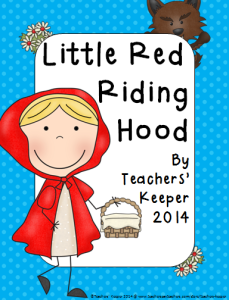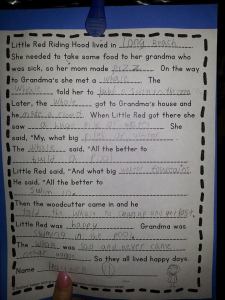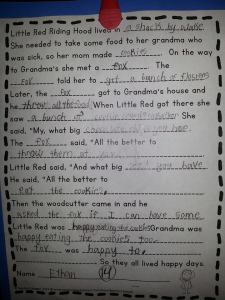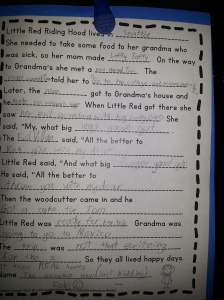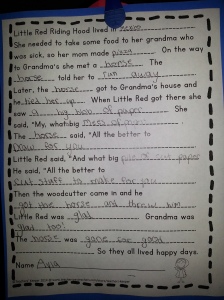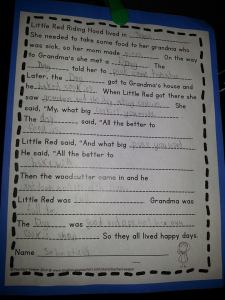“B— is doing so much better!” Those were the exciting words I heard this afternoon when I visited in one of our preschool classrooms. But better at what? Counting? Learning his shapes and colors? Learning the letters? What?! Well, it is more than academics and quite a joy for his teacher.
Flashback to September:
I sit with my colleague who teaches preschool. She is not only new to our school, but new to the profession. She has taken on two ½ day classes of 3 and 4 year olds; half of whom are “model” students for the other half that have qualified for special education services due to being diagnosed with autism, down syndrome, or developmental delays. It’s only the first week of school and she is showing the anxiety on her face as she tells me about the little boy we’ll call “B”.
She is receiving regular comments from families telling her about how their children are afraid of “B” and how they don’t want to come to school. “B” gets into their personal space and stares at them intently; thriving on their reaction, especially two particular boys. In addition to this power play with his classmates, he has bitten my colleague more than once.
As she continues to talk, she shows me the beginnings of a pile of paperwork that she is planning on filling out regarding his behaviors. She just doesn’t know what to do. She asks about how she can protect the other kids, change their feelings about coming to school, change his behavior, and deal with all of the special needs that her students have. I don’t think she knows what she has gotten herself into.
I ask more questions to hopefully guide her towards coming up with her own ideas and solutions. But I quickly realize that her hypothetical toolbox of teaching tools is nearly empty due to lack of experience. I don’t blame her or judge her. I remember being at a loss in my first months on the job too, even though I thought I was very prepared. So, I offer some suggestions; including calling the special education director for specific help in regards to managing children with autism, as this is not a forte of mine. I promise to come in the next day to support her and see how I might better coach her as we move forward.
Cut to a few weeks later: My colleague has new problems to add to her concern about “B”. He’s running around the room and won’t sit on the carpet, let alone stay there during lessons. He’s still intimidating the other children and biting. She’s tried kneeling down and talking to him but he just runs away. Don’t even think about putting him in time-out. After communicating with the special education director, my colleague has enrolled in the annual physical restraint and seclusion training that every special education teacher must participate in. (http://www.specialed.us/S&R/S&R-FAQ.html ) For now, we’ve decided to assign “B” a special spot on the class carpet, provide him a carpet square (much like a sample piece that you can get from carpet stores), and ask her para-educator to keep a special eye on “B” to see if we can at least keep him in the area of the group during lessons. I’ve also committed to providing her with pictures of children sitting on the floor so that her students can see what her expectations are. Let’s start filling her toolbox.


It’s December now and my colleague is using the images of children sitting on the floor, as well as a few other images of her expectations. “B” has taken ownership of the special carpet square that now has his name taped across the top. My colleague has liked this idea so much that she has assigned special carpet spots to a few others as well. Yea! I’m happy to see that “B” likes his spot and he’s with the class…but he still isn’t staying in one spot. Now, little mister “B” likes to take that carpet square and move around several times during a lesson to nearly sitting on his various classmates. They ask him to stop or to move, but he just loves that he’s bugging them. He doesn’t respond to my redirection either. Ugh. To make things even more challenging, my colleague has gained a few more children in her classes and they are all students with IEP’s (Individual Educational Plans). She has students who push and punch, who get into everything, run around, climb on tables, and throw things. Yes, those are typical preschool behaviors, but she has it to the extreme and has little help in the afternoons to manage and teach the 18 students. Though she’s seeing progress with “B” she’s feeling overwhelmed by the work and the pressure to manage it all.
It’s my job as an instructional coach to be a guide on the side and not to directly tell teachers how to do their jobs. I do a lot of listening and questioning. Often, the coachees can come to a realization of what they need to do or try. Sometimes I offer suggestions and I hope to be their support and encourager. I won’t give up on my colleague or “B”.
Now, I have taught preschool, but it’s been over 25 years ago and I didn’t have any special education students. I have a full toolbox of things to try with our special education students, but this little kiddo has got me challenged for effective ideas that will keep him and the other children safe and learning. I think it’s time to call on our current and seasoned special education preschool teachers.
So now it’s February. My colleague and I have visited a couple of other preschool classrooms that have similar demographics. There is so much great stuff going on in other teachers’ worlds and if you have the opportunity I highly recommend visiting other teachers within your area of teaching to see what you might glean from their work. I know I gained a lot from this time. I kept thinking, “Why didn’t I think of that when I taught preschool?” and “I wish I had known that back then.” My colleague took several ideas that she saw and has made them work for her. It’s so neat to see the growth in her students and in her teaching since then.
But what about “B”? Well, he’s growing too. He’s sitting longer on his carpet square and he’s engaging in the lessons more. But he’s still hitting. It’s gotten to a point where his teacher is not only concerned about protecting the other kids but she is reaching a point of sheer frustration. She’s just to her limit with the hitting thing. I don’t blame her. It’s been going on for several months and it doesn’t seem to be better.
And then, we meet in March. We talk about the changes that she’s made and how they are going. We talk about how much easier the changes have made her days. She’s happier. She loves these kids and she truly shows increased confidence. But yet…”B” remains a high focus. As we talk about the things that have worked with him, and try to get to the real reason why he’s acting out the way he does, I think back to one of the teachers in the preschool rooms that we visited. She had a ring of small images attached to her lanyard. They are specific pictures that she uses to help her non-verbal students communicate. She can provide them to students at the drop of a hat. Then it hits me! Why not use that with “B”? Since talking to him doesn’t work, and being more assertive hasn’t helped, let’s go to non-verbals and peaceful communication.
So I suggest to my colleague that she make up a ring of images showing the things that she wants and doesn’t want for “B”. For instance, when he hits, she would take the picture of safe hands and show it to him with a short statement like. “We have safe hands in our school.” Or if he becomes intimidating we show him a picture of a peaceful face and tell him that we “are nice to others.” I know, some of you might be saying, “Duh.” But for us, it was something that we hadn’t done. We knew that he had eventually learned how to sit on the carpet due to the image of a child sitting and lessons that supported that image and expectation. We knew that he liked videos and had begun to respond to other visual clues. Before I left, my colleague was already selecting the images that she would use. That was Friday.

Today is Tuesday. She has tried the behavior images for only 2 days. I walked into her classroom this afternoon and “B” was quietly playing by himself at the building blocks center. I sat with her at a table while she taught a small group of students. As she finished and the students were putting some things into a bag she was holding, she said, “B— is doing so much better!” She told me about how he had started hitting and she showed him the behavior image. He stopped. He focused on her words and even walked to the time out spot with her! He didn’t sit in the time out chair, but they did count to ten together before he returned to play. Since then, he hasn’t hit nearly as often and things are beginning to settle down in her classroom.
I’ll admit that I cheered audibly. It was great news! We know this may only work for a while, but it worked! He is learning and understanding. My colleague is happier. She is building her confidence and filling her toolbox. We take the little successes one day at a time and hope they continue. It had been a long time and it was very rewarding to see success.
I’m so glad we believed in this child and the kept trying different approaches to meet his needs. He still has challenges but he is growing and learning, and for a teacher, that’s what we want most of all. Hurray for “B”! Hurray for my colleague!! I’m excited to see what we can accomplish next.

